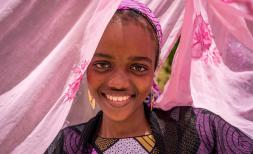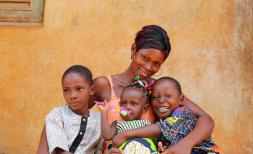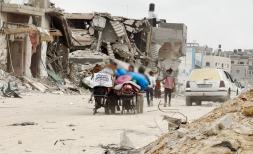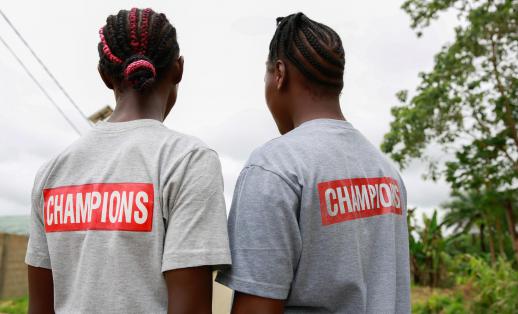Save the Children India gets children to set the agenda for General Elections 2019

India is the world’s largest democracy and in a few weeks, will hold its General Elections. The pace of the 2019 General Elections is already building up with various political parties forming teams, campaign plans and manifestos -- all to be released to the public as part of their possible mandate.
Children are often forced to inherit the harmful consequences of our actions today - or even the consequences of the things we fail to put into action! We cannot talk about the future of our children without including them in the very same decisions that influence their lives.
And so, Save the Children would like to see prospective leaders & political parties in this General Election prepare their respective manifestos after listening to and learning from what children have to say – including their dreams and demands.
Children are not simply passive recipients of government benefits and schemes, but they are holders of rights -- as preserved in the UNCRC. We know that, children, when meaningfully engaged with, can help to shape government policies and programmes which enable more equitable and sustainable development for the entire society. Children are our future, and yet we leave their voices out during key policy discussions, legislative processes and decision-making at various levels.
Save the Children in India has initiated the process of consulting children across 10 states to amplify their voices and fulfil our constitutional commitment to their development and well-being. The consultations have helped us to better understand their demands, as well as their dreams and hopes for future action to be taken by the government and political leaders.
I spoke to Pragya Vats, Campaign Manager at Save the Children India to tell us more about this innovative initiative:
What is Vote4Children?
India is set to become the world’s youngest country by 2020. About 1/3rd of India’s 1.2 billion is made up of children under the age of 18. In a country where nearly 40% of the population comprises of children, it is tragic that their voices are not adequately heard.
Why is that? While they are a large population constituent, they do not constitute a political constituency because they don’t vote.
In order to make their voice and dreams count, we modelled #Vote4Children as a campaign during the 2014 General Elections, which was effectively used at the national and state level to raise children’s issues higher on the political agenda. In other words, #Vote4Children aims to bring important issues for and by children into the mainstream political discourse, so that political leaders can actively include children’s issues in their party manifestos.
Tell us more about what you are doing this year in the lead up to the General Elections.
Over the last six months, Save the Children India held 392 consultations with 12198 children across 10 Indian States and 99 districts. The consultations with children were done in collaboration with children, partners, civil society and other child rights organisations.
Whilst keeping children’s demands as a major priority, we looked at evidence on ground, as well as key policies and implementation gaps in order to propose recommendations that will ensure children can survive, learn, and be protected from harm and abuse.
So, our first step was the formulation of demands. The aim was to listen, understand and include children’s voices and views on the kind of India they want.
We also put a strong social media effort to create visibility, amplify child voices and engage public and political leaders in collaboration with Youth Ki Awaaz - our partner in #Vote4Children since 2014. This year, we are also collaborating with Twitter in India for an offline live event to be held at their office on 28th of March.
Thirdly, a critical and final element included creating an interface between children and political leaders across all parties. We have followed a two-pronged approach- not only did our event act as a unifying platform for different political leaders and representatives of political parties’, but it also gave children the opportunity to present their own manifestos and demands directly to them!

What has been the response until now?
The response has been extremely encouraging so far. We have had key political parties present across state level events in Jharkhand and UP. In Jharkhand, a delegation of children met with the Chief Minister of the State to present the children’s manifesto for inclusion in their party agenda. Similarly, in Delhi, our child delegation team has met with many members of various political parties and they have promised to prioritise children in their party manifesto. Additionally, we have received an impressive amount of media coverage for our #Vote4Children efforts.
What has also worked is the level of engagement from children as spokespeople. They are boldly asking what they want of governments and decision makers. Read some of the powerful voices of young representatives from across states.
Every child’s perspective has been very insightful, in fact I would even say -- powerful. Some just amaze you with their astuteness and others with their simplicity and grit. Each of them have emerged from strength to strength, especially in overcoming their personal challenges and advocating for the rights of children.
For example, 12 year old Faheem from UP, presented a very basic yet crucial demand that children have – the right to play in and access open spaces and playgrounds for children.
19 year old Shailendra from Rajasthan, also gave a nuanced and articulate proposition to the government where he called for key issues in his state to be addressed- including poor access to health and nutrition, education, and sanitary healthcare products for girls.
Rumi from Jharkhand, on the other hand, is a poignant yet feisty advocate for ending child marriage. She is also an advocate for introducing mandatory life skills education and the improvement & protection of children’s healthcare.
Each story and perspective from children like Faheem, Shailendra and Rumi will make you realise something- it is only when we collectively listen to children enough that we can create a real change- a world which they want, a society and nation that is fit for its children. And this is not a wishful thinking.
What do you hope to achieve with this campaign?
Our hope is to put children at the centre of the political discourse in India. As all political parties are gearing up for charting out their promises to citizens ahead of the elections, we would like to see these potential leaders include promises to India’s children. We want political parties and their leaders to make children count. It is time for children to be heard!







